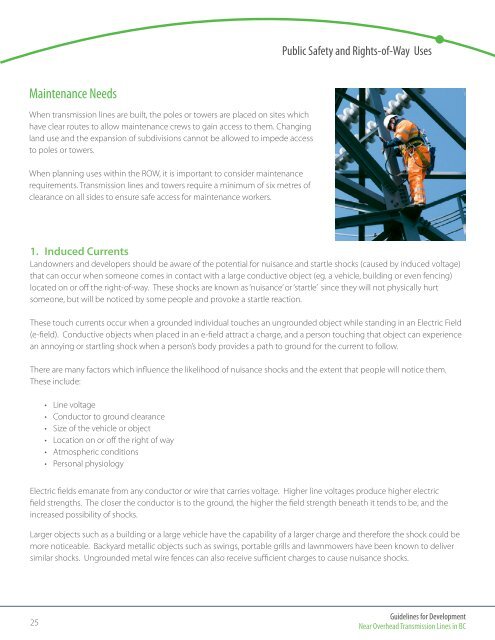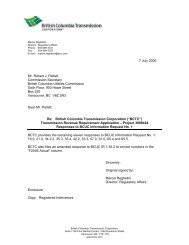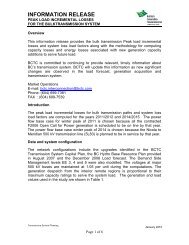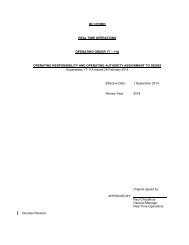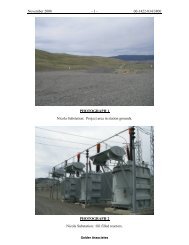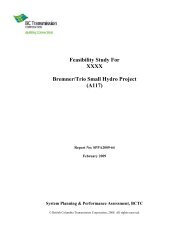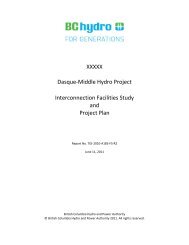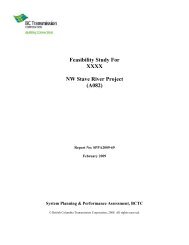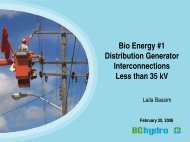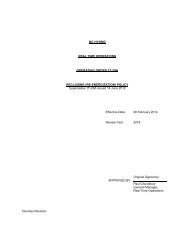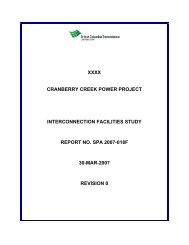Guidelines for Development Near Overhead Transmission Lines in BC
Guidelines for Development Near Overhead Transmission Lines in BC
Guidelines for Development Near Overhead Transmission Lines in BC
Create successful ePaper yourself
Turn your PDF publications into a flip-book with our unique Google optimized e-Paper software.
Public Safety and Rights-of-Way Uses<br />
Ma<strong>in</strong>tenance Needs<br />
When transmission l<strong>in</strong>es are built, the poles or towers are placed on sites which<br />
have clear routes to allow ma<strong>in</strong>tenance crews to ga<strong>in</strong> access to them. Chang<strong>in</strong>g<br />
land use and the expansion of subdivisions cannot be allowed to impede access<br />
to poles or towers.<br />
When plann<strong>in</strong>g uses with<strong>in</strong> the ROW, it is important to consider ma<strong>in</strong>tenance<br />
requirements. <strong>Transmission</strong> l<strong>in</strong>es and towers require a m<strong>in</strong>imum of six metres of<br />
clearance on all sides to ensure safe access <strong>for</strong> ma<strong>in</strong>tenance workers.<br />
1. Induced Currents<br />
Landowners and developers should be aware of the potential <strong>for</strong> nuisance and startle shocks (caused by <strong>in</strong>duced voltage)<br />
that can occur when someone comes <strong>in</strong> contact with a large conductive object (eg. a vehicle, build<strong>in</strong>g or even fenc<strong>in</strong>g)<br />
located on or off the right-of-way. These shocks are known as ‘nuisance’ or ‘startle’ s<strong>in</strong>ce they will not physically hurt<br />
someone, but will be noticed by some people and provoke a startle reaction.<br />
These touch currents occur when a grounded <strong>in</strong>dividual touches an ungrounded object while stand<strong>in</strong>g <strong>in</strong> an Electric Field<br />
(e-field). Conductive objects when placed <strong>in</strong> an e-field attract a charge, and a person touch<strong>in</strong>g that object can experience<br />
an annoy<strong>in</strong>g or startl<strong>in</strong>g shock when a person’s body provides a path to ground <strong>for</strong> the current to follow.<br />
There are many factors which <strong>in</strong>fluence the likelihood of nuisance shocks and the extent that people will notice them.<br />
These <strong>in</strong>clude:<br />
• L<strong>in</strong>e voltage<br />
• Conductor to ground clearance<br />
• Size of the vehicle or object<br />
• Location on or off the right of way<br />
• Atmospheric conditions<br />
• Personal physiology<br />
Electric fields emanate from any conductor or wire that carries voltage. Higher l<strong>in</strong>e voltages produce higher electric<br />
field strengths. The closer the conductor is to the ground, the higher the field strength beneath it tends to be, and the<br />
<strong>in</strong>creased possibility of shocks.<br />
Larger objects such as a build<strong>in</strong>g or a large vehicle have the capability of a larger charge and there<strong>for</strong>e the shock could be<br />
more noticeable. Backyard metallic objects such as sw<strong>in</strong>gs, portable grills and lawnmowers have been known to deliver<br />
similar shocks. Ungrounded metal wire fences can also receive sufficient charges to cause nuisance shocks.<br />
25<br />
<strong>Guidel<strong>in</strong>es</strong> <strong>for</strong> <strong>Development</strong><br />
<strong>Near</strong> <strong>Overhead</strong> <strong>Transmission</strong> <strong>L<strong>in</strong>es</strong> <strong>in</strong> <strong>BC</strong>


